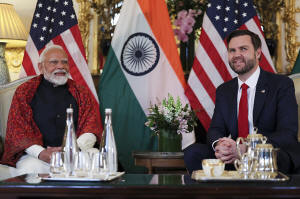Vance and Modi are likely to discuss a potential US-India trade deal.
Here's what to know
[April 21, 2025] By
SHEIKH SAALIQ
NEW DELHI (AP) — U.S. Vice President JD Vance began a four-day visit to
India on Monday as the two countries seek to unlock economic
opportunities and negotiate a bilateral trade deal.
Vance will meet Prime Minister Narendra Modi in New Delhi for talks on
the economy, trade and geopolitical ties. Vance’s visit is seen as an
important diplomatic mission by President Donald Trump’s administration,
and it coincides with a rapidly intensifying trade war between
Washington and Beijing, which is New Delhi's main rival in the region.
A trade deal between India and the U.S. could significantly enhance
economic ties between the two countries and potentially strengthen
diplomatic ties.
The U.S. is also India’s largest trading partner, with bilateral trade
valued at $190 billion until recently.
India’s Foreign Ministry has said the visit will “provide an opportunity
for both sides to review the progress in bilateral relations” and the
two leaders will “exchange views on regional and global developments of
mutual interest.”
Here’s what to know about Vance’s visit:
Bilateral trade agreement
Vance’s arrival in India comes weeks after Director of National
Intelligence Tulsi Gabbard was in India for a geopolitical conference
and two months after Modi met Trump in Washington.
Modi was among the first leaders to visit the U.S. and hold talks with
Trump after he returned to the White House. During his visit, Modi
hailed a “mega partnership” with the U.S. and kickstarted a negotiation
process to minimize the possible fallout of Trump’s tariffs after it had
already cut tariffs on a range of U.S. goods.

Regardless, Trump targeted India with a 26% levy as part of his
now-paused tariff program, which has provided temporary relief for
Indian exporters.
During his visit, Modi sought to soften impending trade barriers by
saying he was open to reducing more tariffs on U.S. goods, repatriating
undocumented Indian nationals and buying military gear. The two
countries also agreed to start talks toward clinching the bilateral
trade agreement.
Modi on Friday said he spoke with Elon Musk, noting that he and the
SpaceX CEO “discussed the immense potential for collaboration in the
areas of technology and innovation,” adding “India remains committed to
advancing our partnerships with the U.S. in these domains.”
India's deep ties to US business
India is a close partner of the U.S. for bilateral trade, foreign direct
investments, defense cooperation and an important strategic ally in
combating the rising influence of China in the Indo-Pacific region.
It is also part of the Quad, which is made up of the United States,
India, Japan and Australia and is seen as a counterbalance to China’s
expansion in the region.
[to top of second column] |

U.S. Vice President JD Vance, right, and Indian Prime Minister
Narendra Modi attend a bilateral meeting at the residence of the
U.S. Ambassador on the sidelines of the Artificial Intelligence
Action Summit in Paris, Feb. 11, 2025. (Leah Millis/Pool Photo via
AP, File)
 Leading U.S. companies such as Apple
Inc. and Google have expanded operations in India in recent years.
Last month, Musk's Starlink entered into agreements with two of
India’s top telecom operators to provide satellite-based internet
services.
To further boost trade ties, the U.S. and India have set an
ambitious target of more than doubling their bilateral trade to $500
billion by 2030 under the expected trade deal agreement.
The negotiations are especially urgent for New Delhi as it could be
hit hard by Trump’s reciprocal tariffs, particularly in the
agriculture, processed food, auto components, high-end machinery,
medical equipment and jewelry sectors. This poses a significant
challenge for Modi's government as it hopes to improve the country's
economy and generate jobs with an export-led recovery.
Modi and Trump already share rapport
Modi established a good working relationship with Trump during his
first term in office. It now appears that the two leaders are likely
to further boost cooperation between their countries, particularly
in trade. Chinese President Xi Jinping is aiming to position Beijing
as a reliable trade partner in the Asia-Pacific region amid rising
tensions with Washington.
India has also already taken a number of steps to win over Trump. It
will purchase more oil, energy and defense equipment, including the
fifth-generation stealth fighter jets, from the U.S.
The U.S., however, wants greater market access for its agricultural
and dairy products in India, but New Delhi has been reluctant so far
as the farm sector employs the bulk of the country’s workforce.
Family trip for Vance
Vance’s visit to India marks his first official trip to the country,
which has added significance for the second family. His wife Usha
Vance — a practicing Hindu — is the daughter of immigrants from
South India.
In his memoir “Hillbilly Elegy,” Vance described his wife as a
“supersmart daughter of Indian immigrants” whom he met at Yale Law
School. Usha’s parents moved to the U.S. in the late 1970s.
Vance will be accompanied by Usha, their children and other senior
members of the U.S. administration, and the couple will visit the
Indian cities of Jaipur and Agra and participate in engagements at
cultural sites, a readout from the White House said.
All contents © copyright 2025 Associated Press. All rights reserved |